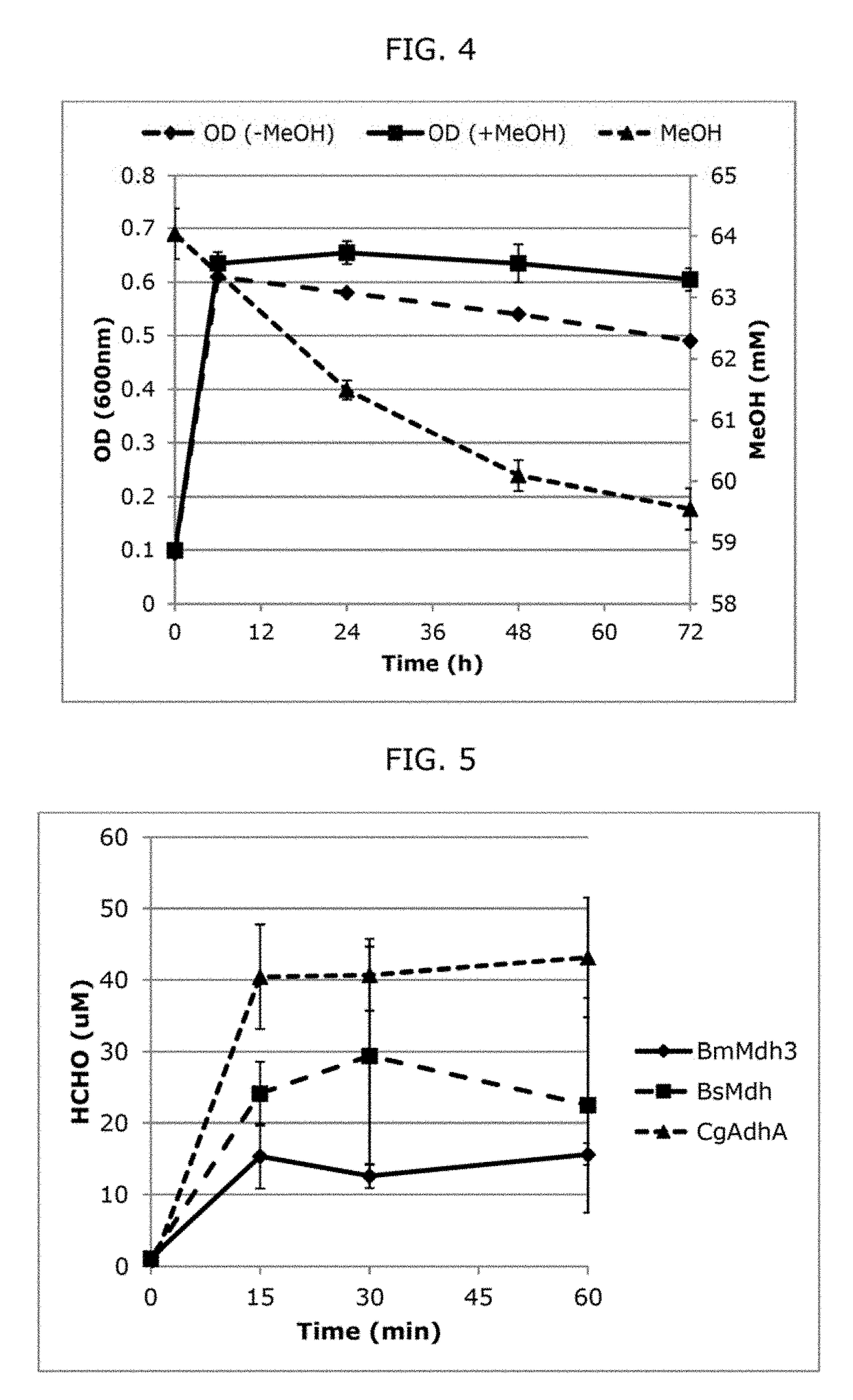Synthetic methylotrophs
a technology of methylotrophs and methylotrophs, which is applied in the field of synthetic methylotrophs, can solve the problems of inability to compete with the fischer-tropsch process for producing liquid fuels, poor transportation of natural gas, and inability to convert chemically to syngas, etc., to achieve the effect of improving the oxidization of methanol, and improving the production of metabolites
- Summary
- Abstract
- Description
- Claims
- Application Information
AI Technical Summary
Benefits of technology
Problems solved by technology
Method used
Image
Examples
example 2
Methanol Utilization in One or Sequential Bioreactors with Optimized Temperature for Optimal MDH Activity
[0081]Thermodynamic calculations show a positive change in reduction potential and negative change in reaction Gibbs free energy when calculated using estimated physiological conditions (Table 2). This suggests that MeOH oxidation via NAD-dependent MDH enzymes becomes more favorable at higher temperatures, i.e., the optimal growth temperature of 45-55° C. of these thermophilic Bacillus methylotrophs. Specifically, the change in the reaction Gibbs free energy (ΔrG) decreases from −1.0 to −2.9 kJ / mol as the temperature increases from 37 to 55° C., suggesting a more favorable reaction at higher temperatures. This further demonstrates that MeOH oxidation via NAD-dependent MDH enzymes is plausible under the physiological growth conditions of mesophiles such as E. coli. As MeOH oxidation via NAD-dependent MDH enzymes is favorable only to a small extent under physiological conditions co...
example 3
y MDH Exhibit Greater Specificity Towards Methanol than Higher Order Alcohols
[0083]We have performed in vivo MDH activity assays comparing the Cgl MDH with the previously described Bst MDH for substrate specificity. Cells were suspended in minimal media containing either 500 mM MeOH only, or a mixture of 500 mM MeOH and 50 mM n-BuOH. MDH activity was assessed by measuring formaldehyde (HCHO) production over time (FIG. 3). Alternatively, 60 mM MeOH or a mixture of 60 mM MeOH and 10 mM n-BuOH was assessed (FIG. 7). Our results demonstrate that the Cgl MDH is less affected by the presence of butanol than is the Bst MDH, likely due to its much higher Km towards butanol (Table 3). Based on these results, we hypothesize that the Cgl MDH is the superior candidate enzyme to be used in the recombinant E. coli strain for the production of biofuel, since product formation will not have as significant of an impact on methanol oxidation.
Example 4. Growth on Methanol and Biomass Labeling from 13C...
example 6
tic and Pathway Analysis
6.a. Conversion of Methanol to Acetyl-CoA and Butanol
[0091]We will engineer E. coli cells to utilize MeOH as a carbon and energy source in an engineered RuMP pathway. To meet ARPA-E yield and energy efficiency we will use CO2 recycling by Schemes 1 or 2 (or 3 if necessary) (Fig.2 of WO 2015 / 108777). In Scheme 1, CO2 is reduced to formate and then HCHO (rxn 2 of FIG. 2 of WO 2015 / 108777) that can be assimilated through the RuMP pathway. Scheme 2 utilizes the rTCA cycle. Backup Scheme 3 uses the glycine cleavage pathway via the glycine synthase. While Schemes 2 and 3 are not as ATP efficient (see rxn 3 of FIG. 2 of WO 2015 / 108777) as Scheme 1, ATP hydrolysis improves the overall thermodynamic outlook of CO2 fixation. Maximum theoretical yields were calculated per ARPA-E instructions for the engineered RuMP pathway with CO2 recycling through either
[0092]Scheme 1, 2 or 3 (Table 4). In both cases (Scheme 1; Scheme 2 or 3), the calculated yields outperform the ener...
PUM
| Property | Measurement | Unit |
|---|---|---|
| Fraction | aaaaa | aaaaa |
| Fraction | aaaaa | aaaaa |
| Molar density | aaaaa | aaaaa |
Abstract
Description
Claims
Application Information
 Login to View More
Login to View More - R&D
- Intellectual Property
- Life Sciences
- Materials
- Tech Scout
- Unparalleled Data Quality
- Higher Quality Content
- 60% Fewer Hallucinations
Browse by: Latest US Patents, China's latest patents, Technical Efficacy Thesaurus, Application Domain, Technology Topic, Popular Technical Reports.
© 2025 PatSnap. All rights reserved.Legal|Privacy policy|Modern Slavery Act Transparency Statement|Sitemap|About US| Contact US: help@patsnap.com



